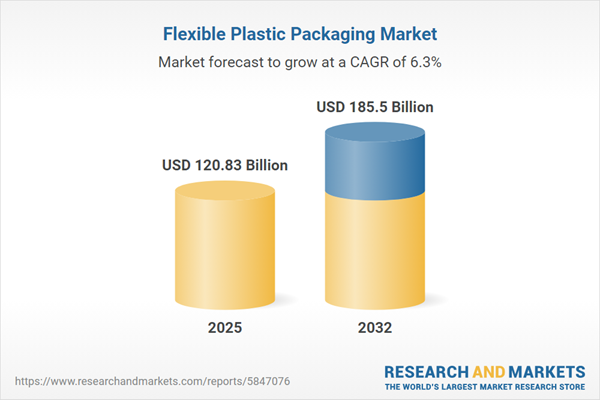Speak directly to the analyst to clarify any post sales queries you may have.
Flexible plastic packaging is rapidly transforming global supply chains, offering manufacturers, brands, and retailers a combination of operational efficiency and sustainability benefits. Industry leaders are navigating an evolving landscape of regulatory pressures, technological advances, and shifting consumer expectations that are driving major changes in how products are packaged and delivered.
Market Snapshot: Flexible Plastic Packaging Market Growth and Trends
The flexible plastic packaging market grew from USD 113.91 billion in 2024 to USD 120.83 billion in 2025, with a projected CAGR of 6.28%. It is expected to reach USD 185.50 billion by 2032. Expansion is attributed to ongoing innovations in material science, rising consumer demand for convenience, and the sector’s rapid adaptation to sustainability and regulatory requirements.
Scope & Segmentation: Industry Structure and Regional Overview
This report provides deep insight into the flexible plastic packaging sector through detailed segmentation and analysis across products, materials, functionalities, packaging formats, end users, and regions.
- Product Categories: Bags, filling films, pouches, sheets and liners, wraps and shrink films
- Bags Varieties: Gusseted bags, wicketed bags
- Pouches Types: Flat pouches, stand-up pouches
- Material Types: Polyethylene, polyethylene terephthalate, polypropylene, polyvinyl chloride
- Functional Features: Barrier protection, durability and strength, flexibility, tamper-evident properties, transparency
- Packaging Formats: Bulk packaging, multi-unit, single-unit
- End-User Applications: Food packaging (bakery, confectionery, beverages, dairy, fruits and vegetables, meat, poultry, seafood), household products, industrial uses, medical supplies, personal care products
- Geographical Regions: Americas (United States, Canada, Mexico, Brazil, Argentina, Chile, Colombia, Peru); Europe, Middle East & Africa (United Kingdom, Germany, France, Russia, Italy, Spain, Netherlands, Sweden, Poland, Switzerland, UAE, Saudi Arabia, Qatar, Turkey, Israel, South Africa, Nigeria, Egypt, Kenya); Asia-Pacific (China, India, Japan, Australia, South Korea, Indonesia, Thailand, Malaysia, Singapore, Taiwan)
- Key Companies: A.B. Polypacks Pvt. Ltd., AEP Group, Alliedflex Technologies Inc, Berry Global Group, Inc., Bischof + Klein SE & Co. KG, Borealis AG, CCL Industries Inc., Cosmo Films, Coveris Management GmbH, Greif, Inc., Huhtamäki Oyj, Jinisha Industries, Klockner Pentaplast of America, Inc., Mccormick Corporation, Mondi Group, Pactiv Evergreen Inc, Printpack Inc., ProAmpac LLC, Safepack Industries Limited, SCIENTEX BERHAD, Sealed Air Corporation, SIG Group, Sonoco Products Company, Swiss Pac Pvt. Ltd., TCPL Packaging Ltd., Transcontinental Inc., Uflex Ltd., Winpak Ltd.
Key Takeaways for Senior Decision-Makers
- Advanced barrier technologies and digital printing are enhancing product protection and elevating consumer engagement.
- Shift toward mono-material films and recyclable solutions is deeply influencing procurement strategies and brand initiatives.
- New tariff policies in the US are shaping strategies in sourcing, logistics, and feedstock security, with an emphasis on supply chain resilience.
- Increased adoption of life cycle assessments and circular economy goals is driving collaboration between brand owners, resin suppliers, and waste management firms.
- Regional factors such as advanced recycling infrastructure in North America, stringent sustainability regulations in EMEA, and rising demand in Asia-Pacific contribute to tailored market strategies.
- Market leaders are investing in vertical integration and partnerships to support innovation in next-generation polymers and digital technologies.
Tariff Impact: Navigating Shifting Cost Structures
Recent tariff changes in the United States have driven up raw material costs for converters and prompted a reevaluation of sourcing and logistics strategies. Industry stakeholders are adapting by negotiating long-term contracts, pursuing backward integration, and investing in regional supply networks to mitigate disruption and maintain operational agility.
Methodology & Data Sources
This report applies a rigorous, multi-tiered methodology, combining secondary research from industry literature and regulatory documents with primary interviews involving executives across the value chain. Findings are validated using quantitative cross-checks and peer reviews, ensuring balanced and actionable insights.
Why This Report Matters
- Enables decision-makers to benchmark operational and strategic initiatives against industry best practices.
- Identifies potential areas for technological investment and supply chain optimization aligned with regulatory requirements.
- Equips B2B stakeholders with regional intelligence to inform entry, expansion, or partnership decisions in a complex competitive environment.
Conclusion
Flexible plastic packaging continues to evolve as industry players respond proactively to innovative trends, regulatory pressures, and regional opportunities. Actionable insights in this report support senior managers seeking to build resilient, future-proof packaging strategies.
Additional Product Information:
- Purchase of this report includes 1 year online access with quarterly updates.
- This report can be updated on request. Please contact our Customer Experience team using the Ask a Question widget on our website.
Table of Contents
3. Executive Summary
4. Market Overview
7. Cumulative Impact of Artificial Intelligence 2025
Companies Mentioned
The companies profiled in this Flexible Plastic Packaging market report include:- A.B. Polypacks Pvt. Ltd.
- AEP Group
- Alliedflex Technologies Inc
- Berry Global Group, Inc.
- Bischof + Klein SE & Co. KG
- Borealis AG
- CCL Industries Inc.
- Cosmo Films
- Coveris Management GmbH
- Greif, Inc.
- Huhtamäki Oyj
- Jinisha Industries
- Klockner Pentaplast of America, Inc.
- Mccormick Corporation
- Mondi Group
- Pactiv Evergreen Inc
- Printpack Inc.
- ProAmpac LLC
- Safepack Industries Limited
- SCIENTEX BERHAD
- Sealed Air Corporation
- SIG Group
- Sonoco Products Company
- Swiss Pac Pvt. Ltd.
- TCPL Packaging Ltd.
- Transcontinental Inc.
- Uflex Ltd.
- Winpak Ltd.
Table Information
| Report Attribute | Details |
|---|---|
| No. of Pages | 181 |
| Published | November 2025 |
| Forecast Period | 2025 - 2032 |
| Estimated Market Value ( USD | $ 120.83 Billion |
| Forecasted Market Value ( USD | $ 185.5 Billion |
| Compound Annual Growth Rate | 6.2% |
| Regions Covered | Global |
| No. of Companies Mentioned | 29 |









